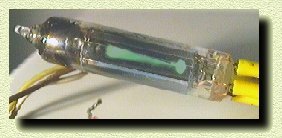 |
Internal view of the chassis from
the top view. You can see on the left the FM group (ECC84 &
ECF80) and on the bottom right the little power autotransformer.
In these cheap receivers this component was used often in
order to obtain a smaller chassis. |
Rear view of this receiver. On the
bottom left you can see a missing dial scale lamp. I don't know
why but during the last restoration (Not made by me..) someone removed
not only the lamp but the lamp holder too, cutting the wire directly
inside the chassis...!! |
 |
 |
Front view of the chassis just removed
from its wood cabinet. You can note the perfect conservation state
of the tuning scale with its band (AM and FM) and the four knobs.
As a typical construction the left one is the ON-OFF switch and
volume control. The window in the top left corner of the tuning
scale is the magic eye window. |
Bottom view with all the components.
The MF-AF group is located in a different box on the top of the
chassis, the rest of the circuit is developed under the metal ground.
The big orange capacitors are the Geloso "dry" electrolitic capacitors
used as anodic filtering. |
 |
 |
Detailed view of the metal label
in the bottom left of the receiver. Present in all Geloso receivers
this plate was used to indicate the nominal operational voltage,
the frequency usage, the model identification but more important
all the tubes used in the chassis. |
Enlarged view of the tuning indicator
(Magic Eye) type DM70. This cheap and little tube was used to indicate
the exact tuning of the choose station. The dimension of the esclamation
point depens directly from the ACG voltage, so more is the power
of the received station more is its lenght. |
 |
 |
This is an enlarged picture of the tuning indicator (magic eye)
type DM70. This little tube works only with four wires, and a low
anodic voltage (80V about).It was used specially in many Geloso
receivers and tape recorders. One of this, the Geloso G255, is part
of my collection and can be found in the main collection page. The
green area of this tube is the plate of the triode. Just modifying
the grid voltage was possibile to obtain a greater o smaller lenght
of the esclamation point, this in order to indicate the correct
tuning or recording volume. Due to its high input impedance the
magic eyes grid can be connected directly to the AGC circuitry without
any signal loss or distortion.
|









